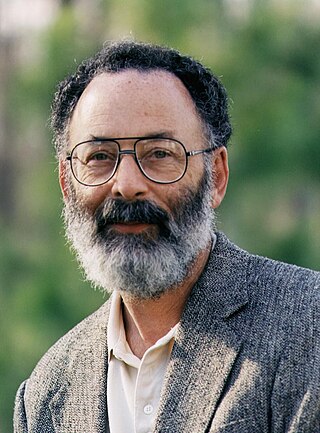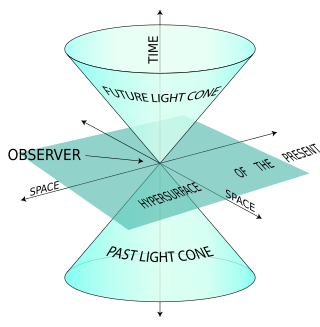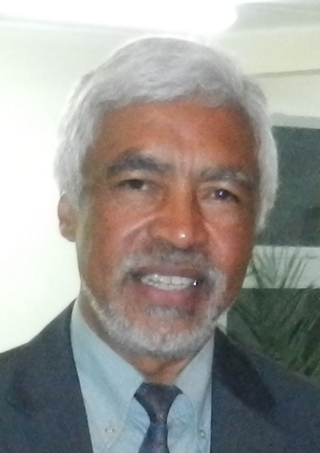Related Research Articles

A gluon is an elementary particle that acts as the exchange particle for the strong force between quarks. It is analogous to the exchange of photons in the electromagnetic force between two charged particles. Gluons bind quarks together, forming hadrons such as protons and neutrons.

In theoretical physics, quantum chromodynamics (QCD) is the theory of the strong interaction between quarks mediated by gluons. Quarks are fundamental particles that make up composite hadrons such as the proton, neutron and pion. QCD is a type of quantum field theory called a non-abelian gauge theory, with symmetry group SU(3). The QCD analog of electric charge is a property called color. Gluons are the force carriers of the theory, just as photons are for the electromagnetic force in quantum electrodynamics. The theory is an important part of the Standard Model of particle physics. A large body of experimental evidence for QCD has been gathered over the years.

In quantum chromodynamics (QCD), color confinement, often simply called confinement, is the phenomenon that color-charged particles cannot be isolated, and therefore cannot be directly observed in normal conditions below the Hagedorn temperature of approximately 2 terakelvin. Quarks and gluons must clump together to form hadrons. The two main types of hadron are the mesons and the baryons. In addition, colorless glueballs formed only of gluons are also consistent with confinement, though difficult to identify experimentally. Quarks and gluons cannot be separated from their parent hadron without producing new hadrons.

Technicolor theories are models of physics beyond the Standard Model that address electroweak gauge symmetry breaking, the mechanism through which W and Z bosons acquire masses. Early technicolor theories were modelled on quantum chromodynamics (QCD), the "color" theory of the strong nuclear force, which inspired their name.

In physics, lattice gauge theory is the study of gauge theories on a spacetime that has been discretized into a lattice.
Mark Brian Wise is a Canadian-American theoretical physicist. He has conducted research in elementary particle physics and cosmology. He is best known for his role in the development of heavy quark effective theory (HQET), a mathematical formalism that has allowed physicists to make predictions about otherwise intractable problems in the theory of the strong nuclear interactions. He has also published work on mathematical models for finance and risk assessment.
Hadronization is the process of the formation of hadrons out of quarks and gluons. There are two main branches of hadronization: quark-gluon plasma (QGP) transformation and colour string decay into hadrons. The transformation of quark-gluon plasma into hadrons is studied in lattice QCD numerical simulations, which are explored in relativistic heavy-ion experiments. Quark-gluon plasma hadronization occurred shortly after the Big Bang when the quark–gluon plasma cooled down to the Hagedorn temperature when free quarks and gluons cannot exist. In string breaking new hadrons are forming out of quarks, antiquarks and sometimes gluons, spontaneously created from the vacuum.
In particle physics, the top quark condensate theory is an alternative to the Standard Model fundamental Higgs field, where the Higgs boson is a composite field, composed of the top quark and its antiquark. The top quark-antiquark pairs are bound together by a new force called topcolor, analogous to the binding of Cooper pairs in a BCS superconductor, or mesons in the strong interactions. The top quark is very heavy, with a measured mass of approximately 174 GeV, and so its Yukawa coupling is of order unity, suggesting the possibility of strong coupling dynamics at high energy scales. This model attempts to explain how the electroweak scale may match the top quark mass.
A conformal anomaly, scale anomaly, trace anomaly or Weyl anomaly is an anomaly, i.e. a quantum phenomenon that breaks the conformal symmetry of the classical theory.
In quantum chromodynamics (QCD), the gluon condensate is a non-perturbative property of the QCD vacuum which could be partly responsible for giving masses to light mesons.
The QCD vacuum is the vacuum state of quantum chromodynamics (QCD). It is an example of a non-perturbative vacuum state, characterized by non-vanishing condensates such as the gluon condensate and the quark condensate in the complete theory which includes quarks. The presence of these condensates characterizes the confined phase of quark matter.
The J. J. Sakurai Prize for Theoretical Particle Physics, is presented by the American Physical Society at its annual April Meeting, and honors outstanding achievement in particle physics theory. The prize consists of a monetary award (US$10,000), a certificate citing the contributions recognized by the award, and a travel allowance for the recipient to attend the presentation. The award is endowed by the family and friends of particle physicist J. J. Sakurai. The prize has been awarded annually since 1985.
In particle physics, chiral symmetry breaking is the spontaneous symmetry breaking of a chiral symmetry – usually by a gauge theory such as quantum chromodynamics, the quantum field theory of the strong interaction. Yoichiro Nambu was awarded the 2008 Nobel prize in physics for describing this phenomenon.

Nathan Isgur was a theoretical physicist from the U.S. and Canada.
Estia Joseph Eichten, is an American theoretical physicist, of the Fermi National Accelerator Laboratory (Fermilab). He received his Ph.D. in 1972 from the MIT Center for Theoretical Physics, where he was a student of Roman Jackiw's, and was Associate Professor of Physics at Harvard before joining the Fermilab Theoretical Physics Department in 1982.

Mikhail "Misha" Arkadyevich Shifman is a theoretical physicist, formerly at Institute for Theoretical and Experimental Physics, Moscow, currently Ida Cohen Fine Professor of Theoretical Physics, William I. Fine Theoretical Physics Institute, University of Minnesota.
In physics, vector meson dominance (VMD) was a model developed by J. J. Sakurai in the 1960s before the introduction of quantum chromodynamics to describe interactions between energetic photons and hadronic matter.
Stuart Samuel is a theoretical physicist known for his work on the speed of gravity and for his work with Alan Kostelecký on spontaneous Lorentz violation in string theory, now called the Bumblebee model. He also made significant contributions in field theory and particle physics.

The light-front quantization of quantum field theories provides a useful alternative to ordinary equal-time quantization. In particular, it can lead to a relativistic description of bound systems in terms of quantum-mechanical wave functions. The quantization is based on the choice of light-front coordinates, where plays the role of time and the corresponding spatial coordinate is . Here, is the ordinary time, is a Cartesian coordinate, and is the speed of light. The other two Cartesian coordinates, and , are untouched and often called transverse or perpendicular, denoted by symbols of the type . The choice of the frame of reference where the time and -axis are defined can be left unspecified in an exactly soluble relativistic theory, but in practical calculations some choices may be more suitable than others. The basic formalism is discussed elsewhere.

Stephan Narison is a Malagasy theoretical high-energy physicist specialized in quantum chromodynamics (QCD), the gauge theory of strong interactions. He is the founder of the Series of International Conferences in Quantum Chromodynamics (QCD-Montpellier) and of the Series of International Conferences in High-Energy Physics (HEPMAD-Madagascar).
References
- ↑ Heavy quarks, p. 10, CTEQ Summer School 2009, Illinois Institute of Technology, retrieved 2016-03-01.
- 1 2 Aneesh V. Manohar; Mark B. Wise (2 July 2007). Heavy Quark Physics. Cambridge University Press. ISBN 978-0-521-03757-0.
- 1 2 Grozin, Andrey (2004). Heavy Quark Effective Theory. Springer Tracts in Modern Physics. Vol. 201. Bibcode:2004STMP..201.....G. doi:10.1007/b79301. ISBN 978-3-540-20692-7. ISSN 0081-3869.
- ↑ Georgi, Howard (1990). "An effective field theory for heavy quarks at low energies". Physics Letters B. 240 (3–4): 447–450. Bibcode:1990PhLB..240..447G. doi:10.1016/0370-2693(90)91128-X. ISSN 0370-2693.
- ↑ Eichten, Estia; Hill, Brian (1990). "An effective field theory for the calculation of matrix elements involving heavy quarks". Physics Letters B. 234 (4): 511–516. Bibcode:1990PhLB..234..511E. doi:10.1016/0370-2693(90)92049-O. ISSN 0370-2693.
- ↑ Isgur, Nathan; Wise, Mark B. (1989). "Weak decays of heavy mesons in the static quark approximation". Physics Letters B. 232 (1): 113–117. Bibcode:1989PhLB..232..113I. doi:10.1016/0370-2693(89)90566-2. ISSN 0370-2693.
- ↑ Shifman, M.A., & Voloshin, M.V. (1987). On production of D and D* mesons in B-meson decays (ITEP--64(1987)). USSR
- ↑ Georgi, H. (1991). TASI Lectures: Heavy Quark Effective Field Theory, retrieved 2016-03-01.
- ↑ Heavy Quark Physics, Mark Wise, 1998